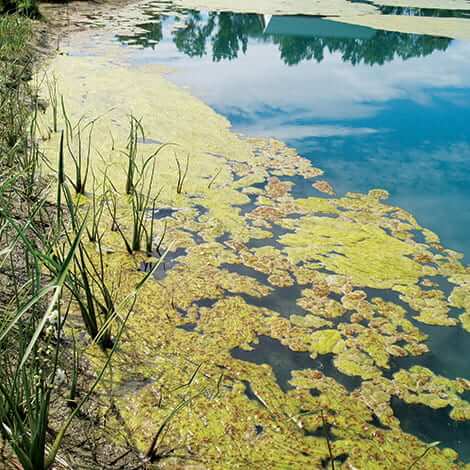Algae is a common nuisance to pond owners, especially in the summer. Sunshine, warm temperatures, reduced oxygen levels and an abundance of nutrients nurture the tiny organisms, and in no time, they may take over your pond.
Algae Explained
Algae does not have a defined root system and often floats on the pond's surface in mats, although it may emerge at the pond's bottom before floating to the surface or even turn the water green. Before treating, it is important to understand the varieties of algae and where they live in an aquatic ecosystem.
The three most common types of algae found in large ponds or lakes are:
- Planktonic Algae: Floating microscopic plants that are suspended in the water column and can quickly alter the water different shades of green, blue-green, brown or variations in between. Commonly referred to as pea soup, planktonic algae can shade the pond's bottom, preventing subsurface nuisance plants from growing, but it can also be a great danger to fish, possibly causing a fish kill if the oxygen depletion is great enough.
- Filamentous Algae: Long threads that grow from the bottom up and intertwine to form mats. Most commonly called pond scum or string algae, the mats will often float to the surface of the pond and will not break apart in your hand. The floating algae can easily cover the entire surface of the pond if left untreated.
- Chara: An advanced form of algae and has gray-green branched multicellular algae. Chara has 6 to 16 leaf-like whorled branchlets that grow in spirals around the stem with thorn-like projections. Chara will not grow to the surface and is often mistaken for submerged plants like Naiad but lacks flowers, true leaves and roots. It is easily identified by its strong musky odor when crushed and it's gritty texture due to calcium deposits on the plant.
Algae Pros and Cons
Surprisingly, algae has many benefits to a pond's ecosystem. The tiny plants feed fish and make great homes for micro- and macro-invertebrates like bugs and worms. But algae has its definite drawbacks. Besides being unsightly and odorous, uncontrolled blooms can cause oxygen depletion, affect fish, and in extreme circumstances, cause fish kills.
When to Treat
The key to successfully treating algae – whether planktonic, filamentous or chara – is to make the most contact between actively growing algae and an algaecide. If the algae is cut or broken into smaller pieces, it's harder for the chemicals to make contact. Because algae do not have a defined root system, it will just keep growing. So it is better to leave the algae as-is before treating it.
Test the Water
Prior to selecting an algaecide, check the water temperature, pH and carbonate hardness. Some algaecides, like Algae Defense, work best when water temperatures are above 60°F. Many algaecides are copper based and should not use with koi, trout, or goldfish unless carbonate hardness (KH) is above 50 ppm. Also, remember to take a look at the product label for any other use restrictions for swimming, fishing, pets and irrigation. Most algaecides do not have water use restrictions though we recommend waiting at least a few hours to be sure there is no contact with the concentrated chemical that was just applied.
- Use Liquid Algaecides. Floating mats of filamentous algae and suspended planktonic algae are best treated with liquid mixtures, such as Algae Defense and KnockDown Defense, that are sprayed directly over the area with a pond sprayer. To treat extra thick mats, stick the nozzle into the mat itself to get the chemical to the deeper portion of the problem.
- Use Granular Algaecides. For bottom-growing algae, use a granular algaecide, like Cutrine-Plus and EasyKlear Defense, and distribute it with a granular spreader. It is the preferred choice because the granules will sink over the algae bed and make maximum contact with it.
Once the algae has died and turned brown, remove as much of the debris as possible with the Razer Rake. This will prevent the decaying matter from becoming muck and fertilizer for future algae blooms.
Proactive Approach
The best way to fight algae and weed growth is to be proactive about pond management. With the use of pond dyes to shade the water, bacteria augmentation and sub-surface aeration, you will be on your way to addressing the root of the problem — excess nutrients and sunlight. Just be sure to wait at least 72 hours after an algaecide treatment to add any beneficial bacteria. Learn more pond management tips read our Airmax Ecosystem article or watch our How to Get Rid of Algae video.
Last Updated: May 16, 2024
